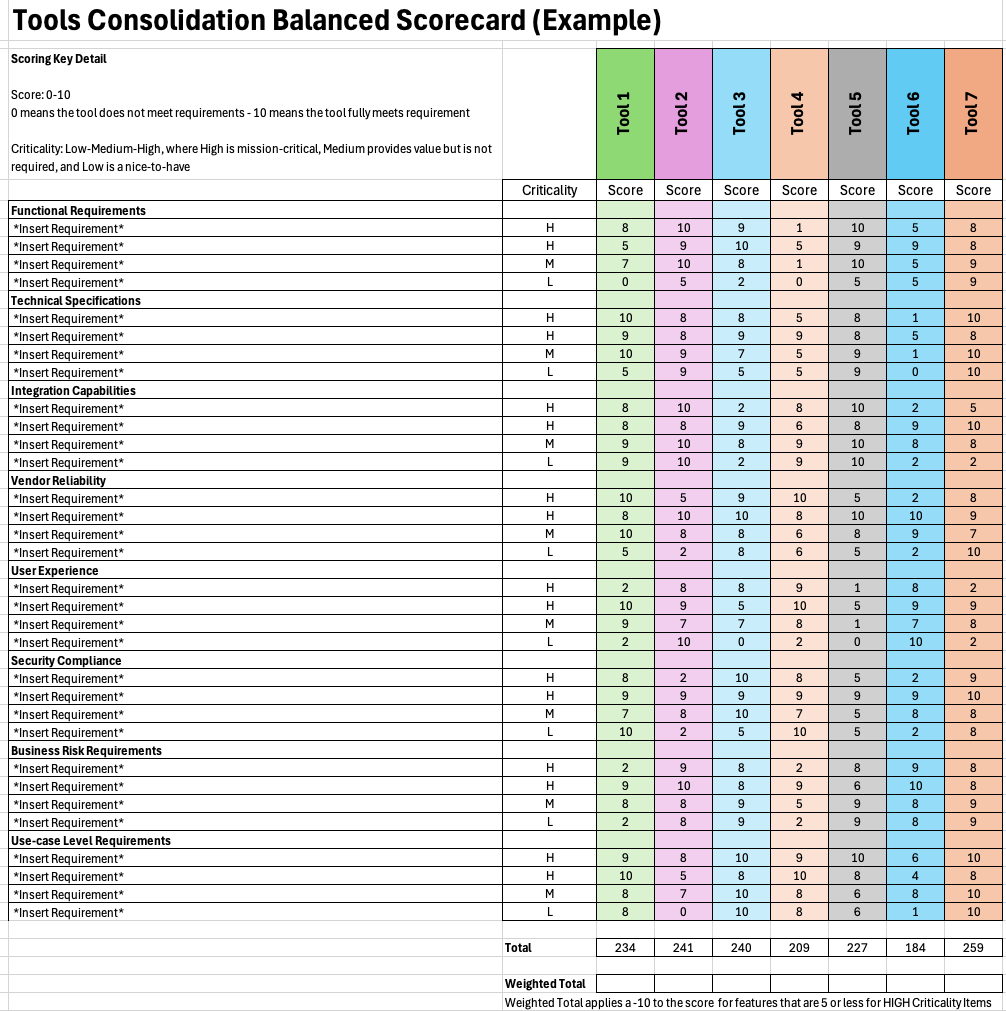Step 1: Assessing your current landscape
Every successful consolidation initiative begins with a thorough understanding of your current tool environment. This means going beyond listing tools — you need a comprehensive audit that captures vendor names, active user metrics, contract terms, licensing costs, and usage patterns.
Timing matters. Aligning this data with your fiscal calendar and key business milestones — like product launches or seasonal campaigns — can reveal opportunities to transition tools without disrupting operations. For example, if a major contract expires just before your fiscal year closes, that might be the perfect time to transition without added chaos.
The goal? Turn raw data inventory into actionable intelligence. By mapping tools against business objectives, you can quickly spot inefficiencies and identify consolidation opportunities without jeopardizing critical functions.
Step 2: Uncovering hidden costs through TCO analysis
Once you’ve mapped your current tool landscape, it’s time to dig deeper into the Total Cost of Ownership (TCO). As discussed in a recent tool consolidation webinar, organizations should consider that TCO encompasses more than acquisition costs. Consider these additional costs or fees:
- Licensing
- Training and onboarding
- Extensive setup or implementation
- User adoption rates
- Maintenance and support
- Downtime and productivity loss
By evaluating TCO alongside these metrics, you gain a holistic view of each tool’s long-term value proposition. This ensures that decisions are both financially sound and strategically aligned. For example, post-consolidation, a large global enterprise reduced their observability tool spend 30% by eliminating redundant and less effective tools in favor of a unified platform approach with little to no redundancy. Because the organization had a target of 20% reduction, they were able to re-invest 10% into expanding licensing in new preferred solutions and scale the SRE teams to embed reliability engineers into development squads. Not to mention eliminating swivel-chair context switching from tool to tool, which based on analysis, companies the size of this enterprise on average spend 10-30 minutes a day context switching from tool to tool. By streamlining, this freed up engineers' time for innovation and higher-impact work.
Step 3: Define functional and technical requirements
Tool consolidation isn’t just about cost savings; it’s ensuring that your tools meet the evolving needs of your organization. Collaborate with stakeholders across departments early in the process to gather critical requirements like:
- Functionality: Does the tool support evolving business needs?
- Technical fit: Is it compatible with existing infrastructure?
- Security and compliance: Does it meet regulatory requirements?
- Scalability: Can it grow with the business?
Stakeholder buy-in is key. When teams feel heard during this process, they are more likely to embrace change. Strategies like transparent communication, phased rollouts, and continuous feedback loops can ease resistance and increase adoption.
This process impacts business agility by allowing organizations to quickly adapt to new market conditions, reduces compliance risk by ensuring tools meet regulatory standards, and fosters innovation by providing a streamlined environment that supports creativity and experimentation.
Step 4: Prioritizing solutions with a scorecard approach
With requirements in hand, a structured scorecard can help objectively evaluate solutions. This approach enables you to assess tools across multiple dimensions such as functionality, integration capabilities, vendor reliability, user experience, and security compliance.
For instance, ranking features on a scale from 0 to 10, where 0 means the tool does not meet requirements and 10 means the tool fully meets them. Additionally, include a business criticality section ranked from Low-Medium-High, where High is mission-critical, Medium provides value but is not required, and Low is a nice-to-have.
Example of scorecard criteria:
- Functional requirements: Does the tool meet the core needs of the business?
- Technical specifications: Is the tool compatible with existing infrastructure?
- Integration capabilities: Can the tool integrate seamlessly with other systems?
- Vendor reliability: What is the vendor's reputation and support quality?
- User experience: How user-friendly is the tool?
- Security compliance: Does the tool meet security standards and regulations?
- Business risk requirements: What are the potential risks associated with tool failure or downtime?
- Use-case level requirements: Are there specific scenarios where the tool must perform optimally

This data-driven framework minimizes bias and fosters transparency among stakeholders, allowing for informed decisions that align with both business objectives and technical requirements.
Step 5: Managing change and monitoring progress
Even the best-laid consolidation plans can fail without strong change management. To ensure successful adoption of new tools post-consolidation, implement tailored training programs and establish feedback loops during and after the transition. Regularly tracking key performance indicators (KPIs) such as user satisfaction, system uptime, cost savings, and productivity improvements provides valuable insights for refining future phases of consolidation.
Change management isn’t just about overcoming resistance—it’s about creating momentum that sustains long-term success.
From Strategy to Execution
Tool consolidation is more than an IT initiative; it is a strategic imperative that drives innovation, resilience, and competitive advantage. By streamlining toolsets, organizations can reduce complexity, enhance security, and improve operational efficiency. Tool consolidation can drive innovation by freeing up resources for strategic projects, enhance resilience by reducing vulnerabilities, and provide a competitive advantage by improving decision-making speed and accuracy.
By following this structured framework — assessing your current landscape, analyzing TCO, gathering requirements collaboratively, prioritizing solutions objectively through scorecards, and managing change effectively — your organization is positioned for long-term success. Leadership alignment remains critical throughout this journey, fostering accountability across departments while ensuring every stakeholder understands the value of consolidation.
Want to make your tech stack work harder for you? Subscribe to the Perspectives monthly newsletter and get the latest insights on tool consolidation and how to drive real business impact.







